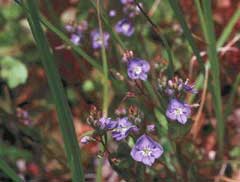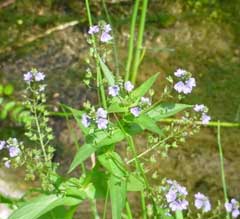 |
|
Gary A. Monroe @ USDA-NRCS PLANTS Database |
 |
| Sheri Hagwood @ USDA-NRCS PLANTS Database |
Translate this page:
Summary
Physical Characteristics

 Veronica americana is a PERENNIAL growing to 0.1 m (0ft 4in) by 1 m (3ft 3in).
Veronica americana is a PERENNIAL growing to 0.1 m (0ft 4in) by 1 m (3ft 3in).
See above for USDA hardiness. It is hardy to UK zone 2. It is in flower from July to August. The species is hermaphrodite (has both male and female organs) and is pollinated by Insects. The plant is self-fertile.
Suitable for: light (sandy), medium (loamy) and heavy (clay) soils. Suitable pH: mildly acid, neutral and basic (mildly alkaline) soils. It can grow in semi-shade (light woodland) or no shade. It prefers wet soil and can grow in water.
UK Hardiness Map
US Hardiness Map
Synonyms
Plant Habitats
Woodland Garden Sunny Edge; Dappled Shade; Pond; Bog Garden;
Edible Uses
Edible Parts: Leaves
Edible Uses:
Leaves - raw or cooked[62, 85, 105, 172]. A hot flavour, it can be used as a watercress substitute[62].
References More on Edible Uses
Medicinal Uses
Plants For A Future can not take any responsibility for any adverse effects from the use of plants. Always seek advice from a professional before using a plant medicinally.
Expectorant
Expectorant[172].
References More on Medicinal Uses
The Bookshop: Edible Plant Books
Our Latest books on Perennial Plants For Food Forests and Permaculture Gardens in paperback or digital formats.

Edible Tropical Plants
Food Forest Plants for Hotter Conditions: 250+ Plants For Tropical Food Forests & Permaculture Gardens.
More

Edible Temperate Plants
Plants for Your Food Forest: 500 Plants for Temperate Food Forests & Permaculture Gardens.
More

More Books
PFAF have eight books available in paperback and digital formats. Browse the shop for more information.
Shop Now
Other Uses
References More on Other Uses
Cultivation details
An easily grown plant, succeeding in a moderately fertile wet soil or in shallow water[1, 200]. Prefers cool summers[200]. Plants do not demand high light levels[200]. Closely related to V. beccabunga[1].
References Carbon Farming Information and Carbon Sequestration Information
Temperature Converter
Type a value in the Celsius field to convert the value to Fahrenheit:
Fahrenheit:
The PFAF Bookshop
Plants For A Future have a number of books available in paperback and digital form. Book titles include Edible Plants, Edible Perennials, Edible Trees,Edible Shrubs, Woodland Gardening, and Temperate Food Forest Plants. Our new book is Food Forest Plants For Hotter Conditions (Tropical and Sub-Tropical).
Shop Now
Plant Propagation
Seed - sow autumn in a cold frame[200]. When they are large enough to handle, prick the seedlings out into individual pots and plant them out in the summer. Division in autumn or spring[200]. Larger divisions can be planted out direct into their permanent positions. We have found that it is best to pot up smaller divisions and grow them on in light shade in a greenhouse or cold frame until they are growing away well. Plant them out in the summer or the following spring.
Other Names
If available other names are mentioned here
Native Range
TEMPERATE ASIA: Russian Federation (Kurile Islands (south), Habarovskij kraj, Kamcatskij kraj, Magadanskaja oblast, Sakhalin), Japan (Hokkaidô, Honshu (north)) NORTHERN AMERICA: Canada (Yukon, Québec, Ontario, Prince Edward Island, New Brunswick, Newfoundland and Labrador, Saskatchewan, Alberta, Manitoba, British Columbia), United States (Alaska, Maine, Massachusetts, New Hampshire, New Jersey, New York, Ohio, Pennsylvania, Vermont, West Virginia, Connecticut, Iowa, Kansas, Minnesota, Missouri, Nebraska, North Dakota, South Dakota, Illinois, Oklahoma, Colorado, Idaho, Montana, Oregon, Washington, Wyoming, Delaware, Kentucky, Maryland, North Carolina, Virginia, Tennessee, New Mexico, Texas (west), Arizona, California), Mexico (Baja)
Weed Potential
Right plant wrong place. We are currently updating this section.
Please note that a plant may be invasive in one area but may not in your area so it's worth checking.
Conservation Status
IUCN Red List of Threatened Plants Status :

| Related Plants
|
| Latin Name | Common Name | Habit | Height | Hardiness | Growth | Soil | Shade | Moisture | Edible | Medicinal | Other |
| Veronica agrestis | Field Speedwell, Green field speedwell | Annual | 0.1 |
0-0
| | LMH | N | M | 1 | 1 | 0 |
| Veronica anagallis-aquatica | Water Speedwell | Perennial | 0.3 |
-
| | LMH | N | WeWa | 2 | 2 | |
| Veronica arvensis | Corn Speedwell | Annual | 0.2 |
4-8
| | LMH | N | DM | 0 | 1 | 0 |
| Veronica beccabunga | Brooklime, European speedwell | Perennial | 0.6 |
4-8
| | LMH | SN | WeWa | 1 | 1 | |
| Veronica catenata | | Perennial | 0.0 |
-
| | LMH | N | WeWa | 1 | 0 | |
| Veronica chamaedrys | Germander Speedwell | Perennial | 0.5 |
3-7
| | LMH | SN | M | 1 | 1 | |
| Veronica hederifolia | Ivy-Leaf Speedwell | Annual | 0.5 |
-
| | LMH | N | M | 0 | 1 | |
| Veronica longifolia | Garden Speedwell, Long-Leaf Speedwell | Perennial | 1.0 |
4-10
| M | LMH | N | M | 1 | 0 | |
| Veronica officinalis | Common Speedwell | Perennial | 0.1 |
3-7
| | LMH | SN | DM | 1 | 2 | |
| Veronica peregrina | Necklace Weed, Neckweed, Hairy purslane speedwell | Annual/Biennial | 0.2 |
0-0
| | LMH | N | MWe | 0 | 2 | 0 |
| Veronica polita | Gray field speedwell | Annual | 0.3 |
0-0
| | LMH | N | M | 2 | 1 | |
| Veronica scutellata | Marsh Speedwell, Skullcap speedwell | Perennial | 0.1 |
5-9
| | LMH | N | WeWa | 1 | 0 | |
| Veronica spuria | bastard speedwell | Perennial | 0.5 |
3-7
| | LMH | N | M | 1 | 0 | |
| Veronica undulata | Undulate speedwell | Perennial | 1.0 |
0-0
| | LMH | N | MWe | 1 | 1 | |
| Veronicastrum axillare | | Perennial | 1.8 |
-
| | LMH | N | M | 0 | 2 | |
| Veronicastrum sibiricum | Blackroot | Perennial | 0.8 |
5-9
| | LMH | SN | M | 0 | 2 | |
| Veronicastrum virginicum | Beaumont's Root, Culver's root, Bowman's Root, Culver's Root, Black Root | Perennial | 1.2 |
3-9
| F | LMH | N | M | 0 | 3 | |
|
Growth: S = slow M = medium F = fast. Soil: L = light (sandy) M = medium H = heavy (clay). pH: A = acid N = neutral B = basic (alkaline). Shade: F = full shade S = semi-shade N = no shade. Moisture: D = dry M = Moist We = wet Wa = water.
Now available:
Food Forest Plants for Mediterranean Conditions
350+ Perennial Plants For Mediterranean and Drier Food Forests and Permaculture Gardens.
[Paperback and eBook]
This is the third in Plants For A Future's series of plant guides for food forests tailored to
specific climate zones. Following volumes on temperate and tropical ecosystems, this book focuses
on species suited to Mediterranean conditions—regions with hot, dry summers and cool, wet winters,
often facing the added challenge of climate change.
Read More
Expert comment
Author
Schwein. ex Benth.
Botanical References
43200
Links / References
For a list of references used on this page please go here
Readers comment
| Add a comment |
|
If you have important information about this plant that may help other users please add a comment or link below. Only comments or links that are felt to be directly relevant to a plant will be included. If you think a comment/link or information contained on this page is inaccurate or misleading we would welcome your feedback at [email protected]. If you have questions about a plant please use the Forum on this website as we do not have the resources to answer questions ourselves.
* Please note: the comments by website users are not necessarily those held by PFAF and may give misleading or inaccurate information.
To leave a comment please Register or login here All comments need to be approved so will not appear immediately.
|
Subject : Veronica americana
|
|
|
|